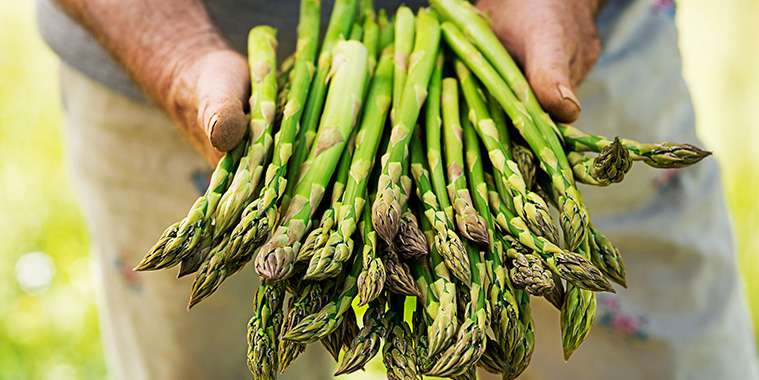By Dorothy Dobbie
Asparagus officinalis grows wild all over the world — even in Manitoba and up to zone 2. It is quite hardy. It is one of the earliest crops.
Look for sunny areas where the soil warms up early in the spring. I have seen it along the riverbanks, but you may also find them along roadways. It is also grown commercially here, and Portage la Prairie is one nearby source.
Asparagus enjoys a lighter, well-drained soil and will grow in salty conditions. In the wild it can be found in batches of 30 or so stalks or just three or four plants or even singly.
Plant asparagus crowns early in spring as soon as the soil can be worked. Loosen the soil to a dept of 12 inches to give the roots he best opportunity to establish. Plants should continue to yield for the next 15 or 20 years.
Like rhubarb, cultivated asparagus takes about three years to establish to the point of harvest. Once established, you can take two or even three crops over a two- to three-week period, cutting when stalks are six to 10 inches long. As the plant matures, you can extend the harvesting period to six or even eight weeks. Fertilize after harvest.
When the days warm up, the plant can grow incredibly fast, so keep your eyes on whatever wild patch you may find.
If you are not sure what to look for, think of the asparagus you have grown in a container at one time or another. Its delicate fronds have no doubt graced a sunny window in your home. That is exactly what mature, uncut asparagus looks like in the wild or in the garden.
What we eat, however, are the sturdy sprouts. The tips of the sprouts contain what will eventually
become the ferns.
Eventually, the female plants develop little bell-shaped, yellow-green flowers that will turn into red berries, beloved by birds, but toxic to humans. More than a handful of berries can cause abdominal pain and vomiting. This fact, and that males are two or three times more productive and are also thicker and sturdier, is why there is a preference for growing male plants.
Very young asparagus are also a bit toxic to humans when eaten raw. The sprouts can cause a mild dermatitis that disappears quickly.
Asparagus is an effective diuretic that has been used to flush out the kidneys medicinally for eons. Hippocrates, the father of western medicine, also prescribed it for pains in the urethra and to alleviate diarrhea. Asparagus rhizomes were thought to enhance fertility, increase milk production in nursing women and alleviate menstrual pains. Turns out the roots contain steroid glycosides which affect hormone production.
If you have been eating asparagus, 60 per cent of the people who use the bathroom right after, you will know it. That’s because asparagine breaks down the odorous sulfur in urine. Asparagus contains an abundance of asparagine, an amino acid (amino acids and proteins are the building blocks of life) that is essential for the functioning of the human brain. Like asparagus, though, humans can synthesize their own asparagine which is also found in dairy, beef, poultry, eggs, fish and seafood. In the plant world, it is found in potatoes, legumes, nuts, seeds, soy and whole grains.
Asparagus is often used as a remedy for hangover, eaten before or after a party. It contains amino acids and minerals that break down alcohol. These same compounds are also thought to protect liver cells from toxins. Asparagus also help to control blood sugars and boosts the body’s production of insulin.
Try planting asparagus near asters, basil, cilantro, dill, marigolds, nasturtium, oregano, parsley, peppers, tomatoes, sage and thyme. Tomatoes and asparagus get along well. Tomatoes repel asparagus beetles and asparagus discourages tomato nematodes.
In addition to all its other virtues, asparagus is a powerhouse of nutrients and minerals. One cup of asparagus gives you 32 calories, and 100 grams provides 20 calories, each while delivering the following recommended daily amounts of Vitamin A (15 per cent); iron (11 per cent); Vitamin C (nine per cent); Vitamin B6 (five per cent) and even three per cent of the magnesium you need every day.
Cooking asparagus makes it easier for us to benefit from the powerful antioxidant, ferulic acid. Ferulic acid is used as an anti-aging ingredient in many cosmetics.
Dorothy Dobbie is the owner of Pegasus Publications, home of Canada’s Local Gardner and Manitoba Gardener.



